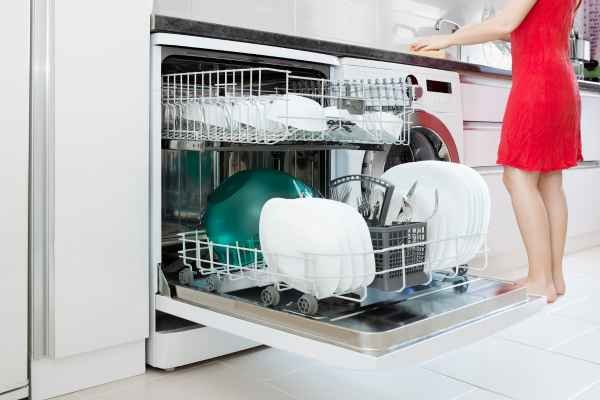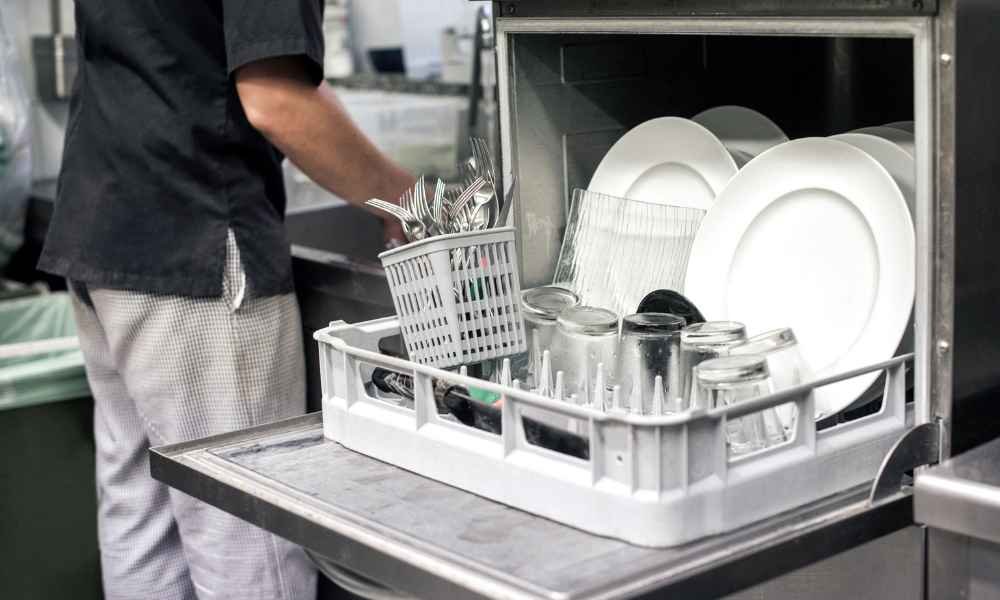Kitchenaid Dishwasher Clean Light Flashing is designed to let you know when a cleaning cycle has completed successfully. When functioning normally, this light simply turns on after the final rinse and drying stages to indicate that your dishes are now clean and ready to be put away. However, if this light starts flashing, it can signal a problem with the dishwasher’s internal systems, such as heating, drainage, or sensor errors. Understanding the light’s intended purpose helps you better interpret when something has gone wrong, and allows you to respond accordingly.
Why Your KitchenAid Dishwasher Clean Light Is Flashing Suddenly
If your KitchenAid dishwasher’s clean starts flashing unexpectedly, it’s likely trying to alert you to an error during the last wash cycle. Most commonly, this flashing means that the dishwasher failed to meet the required water temperature, often due to a heating element or thermostat issue. Another reason could be an incomplete drain cycle or a sensor not working correctly. Since the clean acts as a basic error indicator, a sudden flash should prompt you to pause usage and inspect the machine or consult the user manual.
Common Reasons Behind a Flashing Clean Light
Several issues can trigger the clean to flash. One of the most frequent culprits is a faulty heating element, which prevents the dishwasher from reaching the necessary temperature to sanitize dishes. Clogged filters or blocked spray arms may also interrupt the cleaning process, causing the system to register a fault. Additionally, a tripped thermostat, malfunctioning control board, or power interruptions during the cycle can trigger the flashing light. Identifying the root cause is the first step to resolving the issue and getting your dishwasher back in top condition.
How to Identify Error Codes When the Clean Light Flashes
Many KitchenAid dishwashers are equipped to show hidden error codes alongside the flashing clean light, offering clues about what’s wrong. You can access these codes by running a diagnostic mode, usually involving a specific button sequence on the control panel (such as pressing “Heated Dry” and “Normal” alternately). Once the diagnostic cycle runs, error codes may appear on the digital display or be indicated through a specific pattern of blinking lights. Each code corresponds to a particular issue—such as “6-1” for a water inlet problem or “7-1” for a heater circuit failure—helping you pinpoint the exact malfunction.
Types of KitchenAid Dishwashers and Their Light Indicators
Front Panel vs. Top Panel Designs

KitchenAid dishwashers come with varying control panel designs, which affect how and where the clean indicator appears. Front panel models display indicators on the outside, making them easy to see at a glance. In contrast, top panel designs keep the control panel hidden on the top edge of the door, offering a sleeker look but requiring you to open the door slightly to view indicators. Regardless of placement, the flashing clean light functions the same way across both styles.
Basic vs. Advanced Models

Basic KitchenAid dishwasher models rely more on manual diagnostics and simple light codes to indicate problems, while advanced models often come with digital displays and built-in error detection. The clean indicator in premium models may also work alongside other symbols or text messages, giving more context when issues arise. Advanced models might also offer mobile alerts or app integration for error reporting. Knowing your model type can help you follow the correct steps to address a flashing clean.
Step-by-Step Guide to Reset a KitchenAid Dishwasher with Flashing Clean Light
Manual Reset Method

If your KitchenAid dishwasher’s clean is flashing, a simple manual reset might resolve the issue. Start by unplugging the appliance from the power source or switching off the circuit breaker for at least one minute. This hard reset gives the internal control board a chance to reboot. After turning the power back on, wait to see if the clean has stopped flashing. If not, proceed to a more targeted reset method.
Heated Dry Reset Method

This method works for many KitchenAid models and involves a button sequence. Press the “Heated Dry” button, followed by the “Normal” button, and repeat the sequence: Heated Dry > Normal > Heated Dry > Normal. The control panel should light up, and the dishwasher will enter diagnostic mode. Allow it to complete the cycle without opening the door. This often clears minor faults and resets the flashing clean light.
Control Panel Button Sequence

Depending on your model, there might be a slightly different sequence to initiate a reset. Some dishwashers require pressing “High Temp Wash” and “Heated Dry” in succession. Always refer to your user manual to find the exact sequence that matches your model. Once the panel lights blink or the dishwasher runs a short cycle, you’ll know the reset process has started.
Quick Fixes You Can Try Before Calling a Technician
Before you reach for the phone, try these quick DIY remedies. First, make sure the door is securely latched and that nothing is blocking the spray arms. Clean the filters at the bottom of the tub, as clogs can interrupt water flow and cause error signals. Also, inspect the float switch (usually a small dome or disk inside the tub) to ensure it’s moving freely. If it’s stuck, your dishwasher may falsely detect a water overflow. Resetting the control panel, cleaning the filters, and checking the water inlet valve are simple steps that often solve the issue without professional help.
The Role of the Heating Element in Clean Light Malfunctions
The heating element plays a crucial role in drying dishes and ensuring water reaches the required sanitation temperature. If the element fails or becomes corroded, the dishwasher cannot complete the cleaning cycle properly, prompting the clean to flash. You can test the element with a multimeter for continuity or look for visible signs of damage. Replacing a faulty heating element can often stop the clean light from blinking and restore normal operation.
When a Flashing Clean Light Points to Drainage Issues
Improper drainage is another common cause of the clean flashing. If water remains pooled at the bottom of the tub after a cycle, check for blockages in the drain hose or air gap. A kinked hose, clogged filter, or faulty drain pump may prevent proper water expulsion. In many cases, removing debris or straightening the hose can resolve the issue. Run a rinse cycle after addressing the drainage problem to see if the flashing light clears.
How to Check the Thermostat and Its Connection to Flashing Lights
The thermostat in a KitchenAid dishwasher monitors the internal water temperature and signals when it reaches the appropriate level for sanitisation. If the thermostat malfunctions or misreads temperatures, it may prevent the cycle from completing, causing the clean light to flash. You can test the thermostat with a multimeter to check if it has electrical continuity. If the reading shows no continuity, the thermostat may need replacement. Keeping this component in working order ensures that your dishwasher heats water properly and avoids unnecessary interruptions.
Cleaning the Filters and Spray Arms to Prevent Light Errors
A clogged filter or spray arm is one of the most overlooked reasons behind dishwasher errors, including a flashing clean light. Food particles, grease, and hard water deposits can build up over time and block water flow, affecting the cleaning cycle. To prevent this, regularly remove the lower filter and mesh screen, and rinse them under warm water with dish soap. Use a soft brush to clean any gunk lodged inside the spray arm holes. Keeping these parts clean not only improves wash quality but also prevents the dishwasher from detecting incomplete cycles that trigger error lights.
Power Supply and Wiring Problems That May Cause the Clean Light to Blink
Electrical issues can also cause your KitchenAid dishwasher’s clean to blink. If the unit isn’t receiving consistent power or if there are loose wires, it may not complete its cycles properly. Check your circuit breaker to ensure it hasn’t tripped. Also, inspect the power cord and terminal block for frayed wires or burn marks. In some cases, internal wiring near the control board may be damaged, especially if the dishwasher has been recently moved or jostled. These kinds of issues usually require a professional technician, but identifying a power inconsistency early can save you from more serious damage.
Eco-Friendly Tips to Keep Your Dishwasher Running Smoothly
To keep your dishwasher functioning efficiently while reducing environmental impact, adopt a few simple green habits. Only run full loads to maximise water and energy use. Choose eco or energy-saving cycles, which use lower temperatures and shorter times. Clean your dishwasher with a monthly white vinegar rinse to dissolve buildup without harsh chemicals. Avoid pre-rinsing dishes under running water—just scrape off solids and load directly. These sustainable practices reduce energy bills and wear on your appliance, lowering the chances of malfunction and flashing error lights.
When to Replace vs. Repair: Making the Right Call for Your Dishwasher
If your KitchenAid dishwasher’s clean keeps flashing despite all efforts, you may wonder whether it’s time to repair or replace the unit. Start by evaluating the age of your dishwasher—if it’s over 10 years old, frequent repairs might not be worth the cost. Compare the price of a major part replacement (like the control board or motor) with the cost of a new unit. If repairs exceed 50% of the cost of a new dishwasher, replacement often makes more sense. Also, consider energy efficiency—newer models may offer long-term savings that justify the upfront expense.
Preventive Maintenance Tips to Avoid Clean Light Issues in the Future
Avoid future clean light problems by sticking to a simple maintenance routine. Clean the filters and spray arms every two weeks, and run a cleaning cycle monthly using dishwasher-safe cleaner or white vinegar. Inspect and wipe down the door seals to prevent mildew. Make sure the float switch is moving freely, and periodically check the heating element for scaling. Don’t overload the dishwasher, and follow manufacturer guidelines for detergent type and quantity. These proactive steps keep your dishwasher running efficiently and reduce the chance of annoying indicator lights.
Final Thoughts
A flashing clean light on your KitchenAid dishwasher isn’t just a nuisance—it’s a call to action. Whether it’s a minor clog, a heating fault, or a sensor glitch, tackling the issue head-on can save you time, stress, and money. Most problems have simple solutions if caught early. By staying informed, performing regular maintenance, and knowing when to call in a professional, you’ll keep your dishwasher running smoothly and your kitchen worry-free.
